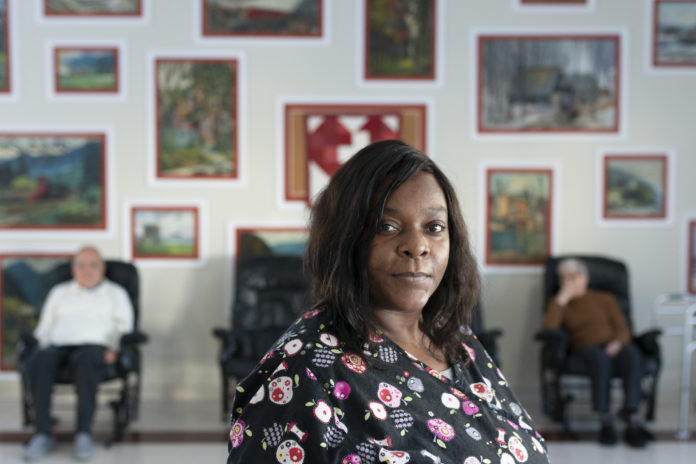

David Champagne lives in Maisonette, a little community on the Acadian Peninsula. At the beginning of the pandemic, Champagne and some of his fellow photographer friends decided they wanted to add some positivity to their social media timelines and challenged themselves to post one photo a day on social media.
One of the photos that Champagne posted was a portrait of an essential worker at a grocery store as a cashier. Because of the COVID-19 distancing regulations at the start of the pandemic, Champagne took the photo through the window.
Shortly after posting it, a communication manager from the Réseau en Immigration Francophone du Nouveau-Brunswick, an organization that works with francophone immigrants in the province, noticed the photo.
“After a moment, I made a huge post about only essential workers in my area. Then [the communication manager] had the idea. She approached me to build this project on essential immigrant workers,” said Champagne.

The project, titled Héros de l’immigration, features 21 portraits of newcomers to the province who are also francophone essential workers.
The exhibit will be in Dieppe until Feb. 8 and then it will come to Fredericton where it will be shown at the Centre Communautaire St. Anne. Afterwards, the exhibit will go to the Acadian Peninsula in June.
The portraits are accompanied by a QR code which leads to an interview with the workers. The interviews are done in French and feature the voices and stories that display the heroism of the essential workers.
The subjects of the portraits include nurses, truckers, cleaners, personal support workers and grocery store employees. Champagne said he tried to take photos of people in their work environment but because of restrictions, that was not always possible.
One worker, who could not be shown at her workplace, was Patience Nagbe, a home care worker who worked in the basement apartment of an elderly woman.
“It was a very small apartment. When I arrived there to do our portraits it was bath time. So, I waited in the kitchen and I heard the extent of her work, which really impressed me,” said Champagne.
He said this exhibit can offer some perspective for those who are frustrated with COVID-19.
“We are all tired of the pandemic. I heard many stories about people working in the healthcare system and it’s not easy. I think they are tired of this. They have to always fear the virus. They have to work harder during the pandemic,” said Champagne.
He said one thing that surprised him was the northern areas of the province becoming more diverse. He said it was exciting to see new businesses and cultural influences popping up in the French part of the province.
“What I learned is in a place like Campbelton or Edmundston, they’re beginning to have a little community of French immigrants. They’re beginning to have grocery stores and special projects for new people in the city,” said Champagne. “So, it’s very interesting because the face of these smaller cities are beginning to change slowly.”
